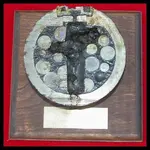Bryanhashemi wrote:
> Did any cannonballs have lead in them?
Bryan, actually, the majority of civil war Field Artillery Smoothbore artillery calibers (6, 12, and 24-pounder) of cannonballs had lead antipersonnel balls inside them. That type of ammo was called "Case-Shot" shells. (Artillery shorthand lingo for enCASEd-SHOT, meaning antipersonnel balls inside the shell's body.)
Your find from the siege of Savannah GA (December 1864) is a yankee 12-pounder caliber Bormann-fuzed Case-Shot, missing the fuze. The unusually large size of the fuzehole is what tells me it had a Bormann fuze (which was approximately 1.5-inches in diameter). Coming from a Dec 1864 battle location, it can only be a yankee one, because although the Confederates made some Bormann-fuzed shells, the CS version was so often defective that they stopped manufacturing it in early 1863. The Confederates were extremely unlikely to have had any of those left at the end of 1864.
Here's a photo of a sawed-in-half yankee Bormann-fuzed 12-pounder Case-Shot. In this specimen, the lead antipersonnel balls were cemented in place by a matrix of asphalt (tar) -- but in others, sulfur or pine-resin was used as the matrix. A tunnel or "well" (which you see in the photo) contained the shell's powder-charge, going straight down under the fuze through the balls-&-matrix to the bottom of the shell. The most probable reason your Case-Shot shell is missing its fuze is that it was a fired "dud" which a soldier picked up and removed the fuze to get the powder out of the shell. Soldiers would do that because gunpowder is the best way to get your campfire started when all the available firewood is wet -- which was a frequent problem for soldiers in combat operations.







